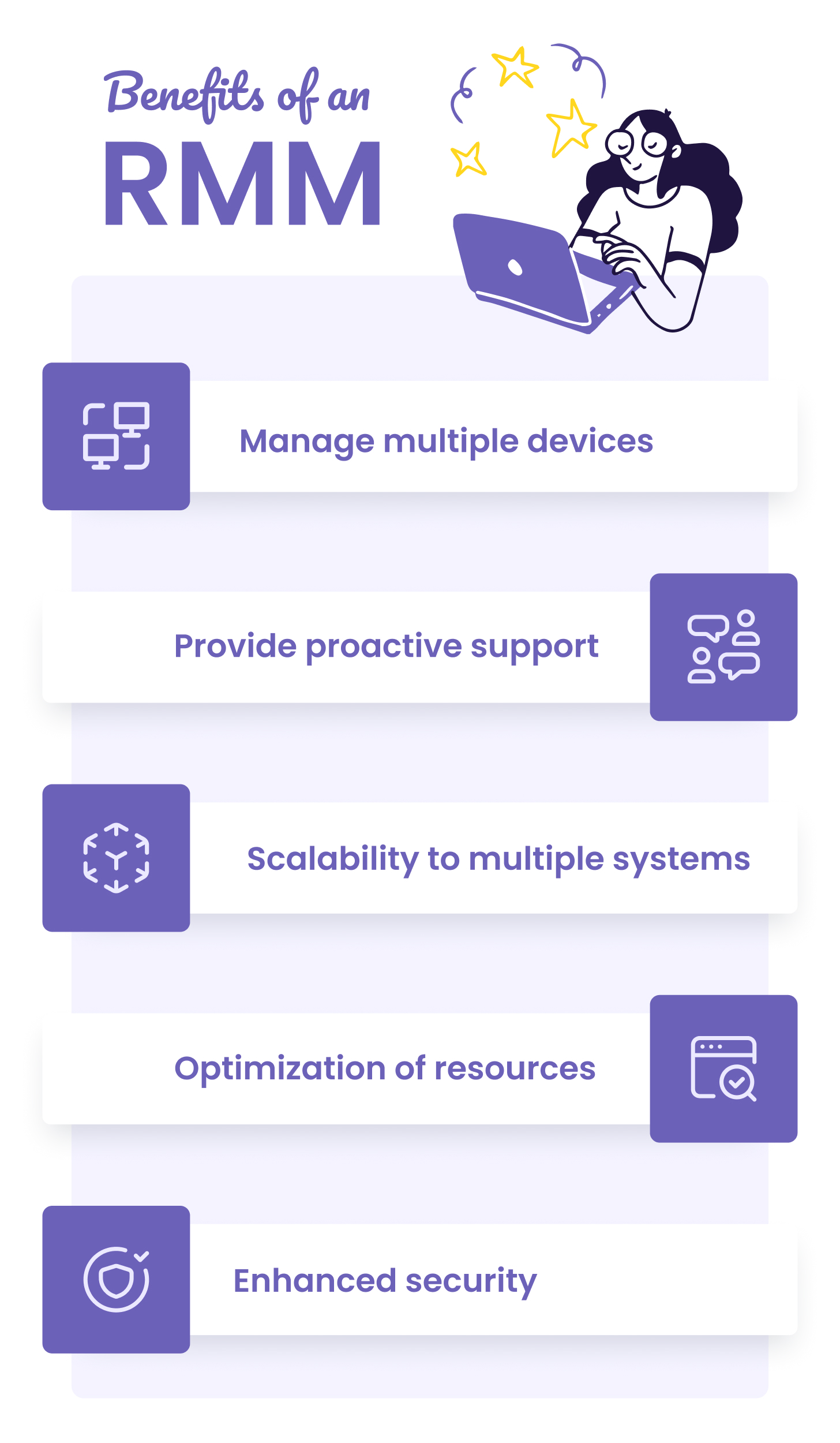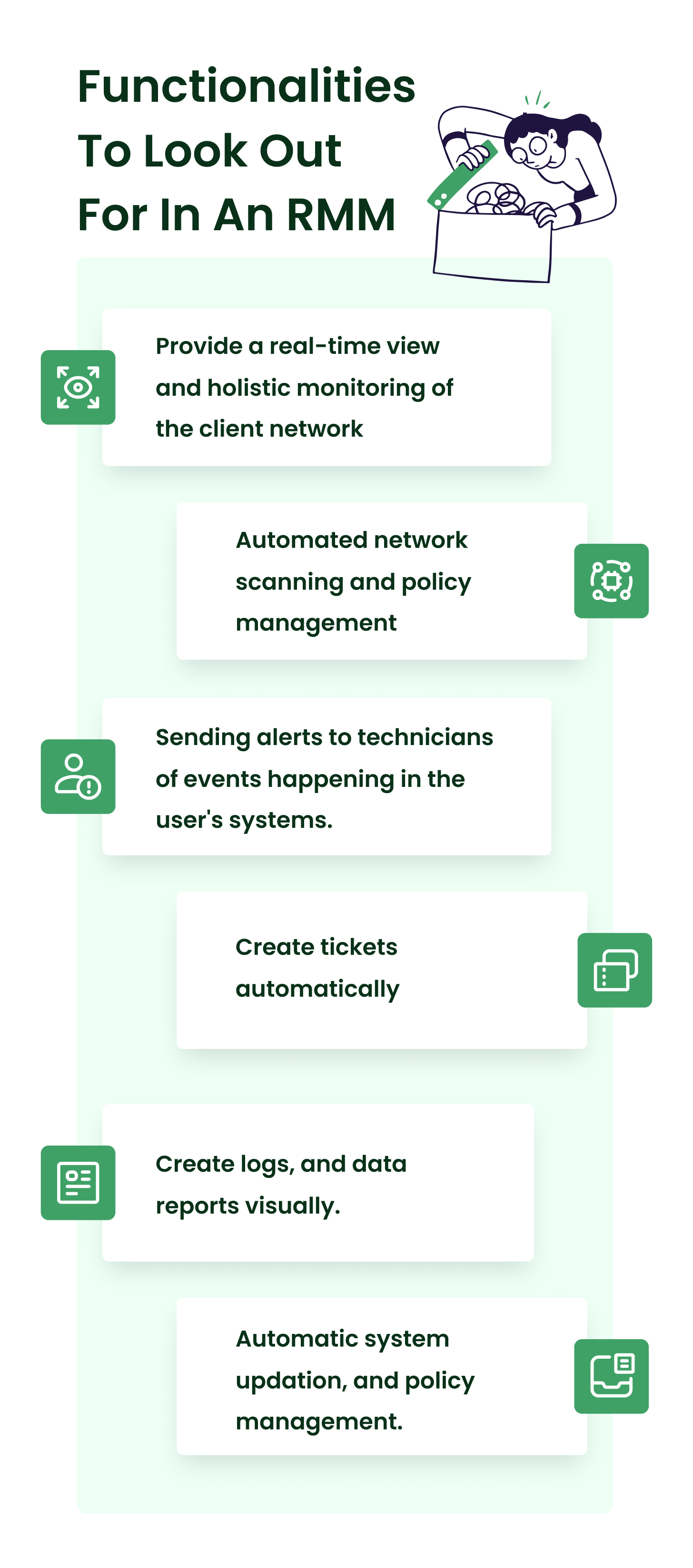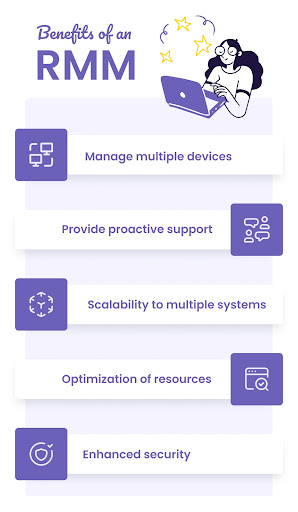What is RMM - Everything about Remote Monitoring and Management
Remote Monitoring and Management, also known as RMM, enables IT and Managed Service Providers to monitor client endpoints, computers, and networks remotely.
TRY MODERN RMM SOFTWAREAs we move into remote and hybrid work environments, the need for efficient IT management has never been more critical. Remote Monitoring and Management (RMM) is the perfect solution that seamlessly bridges the gap between distance and productivity.
Unless we are looking at a small office with a handful of devices, it's hard to find an IT support setup that can actually ensure uptime, safety, network updates, and optimum performance of all its IT infrastructure without the use of the Remote Monitoring and Management (RMM) tool.
This makes it imperative that you understand the need, functions, benefits, history, and future of RMM tools for Managed Service Providers. Now let’s delve deeper into RMM.
What is Remote Monitoring and Management (RMM)?
Remote monitoring and management is a process that allows IT admins, technicians, internal IT teams, and/or IT MSPs to monitor and manage IT networks and all the remote devices (endpoints) connected to them “remotely”. It’s sometimes also called remote IT management or network management.
RMM is an acronym used interchangeably for both — the process and the tool, used for this purpose; like SuperOps.ai, an industry-leading RMM.
Remote monitoring and management work on an agent-server structure.
Agent
An agent is a piece of software installed on all endpoints and nodes on the network constantly feeding data about the device's health and performance to the server.
Server
The monitoring and management bit happens at the server side from where the manager or technician can see real-time and historical data about each point, section, or the entire network at a glance. Think of it as a central command center for sending across any instructions or updates to the endpoint agent for execution or implementation.
This entire exchange of information is stable, secure, and happens in real-time. The agents can detect, and at times predict, any issues that have happened or may arise on the endpoint and hamper work and the enterprise network. In such scenarios, they raise alerts to the tech team managing the network or the agent assigned to those endpoints. Some RMMs also raise a ticket with relevant information and put it in the queue for discovery and resolution by the IT MSP.

Why do you need RMM?
As we mentioned earlier, RMM emerged from the needs of a modern IT infrastructure manager and more so of an IT MSP. The world has largely moved on from the break-fix approach where the thumb rule was “if it ain’t broken, don’t fix it”. The idea is that if something is working, even if it's poorly, is better for business than trying to fix it. Though many micro, mini and small businesses still practice this, it’s definitely not best for business in the long-term, and entrepreneurs are understanding this much earlier than before in their journeys. Also, this doesn’t work at larger companies where the entire network is only as efficient and secure as the least updated and least secure device on it.
Large office networks with a huge number of users and devices spread across locations and sometimes on the move cannot depend on local teams for IT infrastructure management. There are multiple needs of IT infrastructure management that can be solved with an RMM agent in place.
Need a robust RMM solution for your business? |
Functions of a modern RMM
There are a few core functions that must be handled by all modern RMMs. Usually in all of these, you will see a mix of monitoring and management; with one enabling the other. Let’s take a deeper look at them:
Real-time viewing and holistic monitoring of the client network
An RMM for IT MSPs monitors the health of individual devices, nodes, and the complete network at all times in real time. This means it ensures that hardware, software, and connectivity are up and working at all times at all places.
Automated network scanning and policy management
Good RMMs are equipped with automated network scanning and discovery too, which means as soon as a new device is plugged into the system, it adds it to inventory, applies all relevant policies, and installs an agent software. If it doesn’t have permission to install the agent or administer the policies on a device on the network it can at least prompt the user to do it and if he or she doesn’t do it, it can limit their access to the system or inform the admin which leads us into the next function.
Sending alerts to technicians of events
In case of an IT event taking place, the RMM must send an alert to concerned teams or technicians who are in charge of that department or those endpoints. Now, this does not have to be a failure at an endpoint or network device. It can be an alert like an unauthorized new device trying to perform certain functions — failed or succeeded — citing an attempt at breach or security lapse. It can be a prediction that decreasing the efficiency of a particular section of the network can affect the functioning of multiple business units depending on it and call upon techs to update it.
Create tickets and assign them
As part of identifying or predicting a possible issue, an RMM must create a ticket with all the relevant data available and assign it to the right agent/team or queue for easy and timely resolution of an issue. The ticket can contain reports leading up to the event, the possible causes of the issue, and steps to resolution maybe. It’s a learning process and once an event occurs and a solution is successful, it can be used as a template for possible resolutions.
Create logs, and data reports, analyze and visualize them, and share them
As the RMM keeps collecting real-time data, it must log the data every time it goes through a monitoring cycle. This helps in understanding the network progress and device health over time, usage, and their relations to any events. This analysis can then be used to optimize the network's health and performance. Also, for an MSP to showcase how their work has improved network health and performance over time for the client.
Automatic system updates, policy, and patch management
We’ve covered this in a scattered manner above but it is the core of an RMM; specifically, the second M that stands for Management. Cost-cutting and time saved on keeping the network stable, updated, and secure are some of the best parts of RMM.
The policies set by the tech team or IT MSP are instantaneously applied to any devices connected to the network and tries to perform certain functions or access certain tools or network drives. It automatically installs patches at a fixed schedule to the concerned devices.
It also helps install any software updates required for network devices. In rare cases, it can also initiate the rollback of patches and updates if any major issue is detected.
This automation is one of the key benefits of the new age cloud-based RMM solutions like SuperOps.ai which save companies millions in time and cost savings and improved system efficiencies.

Benefits of RMM
Security
Your local IT team can provide an employee with an updated and protected piece of equipment to access the network. But how can you be sure that it remains that way and monitor the usage patterns without an RMM agent in place?
This is a constant need here to ensure that all devices connected to the network are secure. There should be no malware or spyware leaking information, or unauthorized access to the network via the device, and in case of a malfunction or any device going missing, it must be swiftly wiped and locked; bricked if possible.
But how is this possible without RMM agents monitoring it all the time?
This is just one scenario.
Ease of access
Let’s look at an example where an employee is on the move or working remotely. He is halfway across the world where his device’s connectivity is not stable due to a lack of some software patches. What would be an easier option —
a) Asking the employee to report with his device to the closest office location
b) Having an RMM agent onboard the device allows the tech to remotely update the device and get it up and running.
RMM has the capability to solve IT MSP’s multiple issues. Even if you can reach and service every endpoint (longshot) and have scheduled check-ins to help you preempt any upcoming network and device issues, there is no scope for real-time network checks and endpoint health hygiene on your own. An RMM can detect real-time issues and trigger an alert to ensure that they are tackled at the earliest.
Constant repairs and downtime not only affect the client’s business and morale but also reduce their confidence in your ability as an MSP or an IT support provider. Proactive monitoring and service improve uptime, stability, and machine life making it cost-effective and providing customer satisfaction.
Scalability
RMM allows you to set up processes the way you prefer — assign a single POC technician to address multiple endpoints across different locations or handle one-on-one IT management processes for endpoints and networks spread across.
As an IT MSP, you can onboard more clients and support more endpoints, networks and IT requirements with smaller teams and this expansion takes much less time than conventional transitions. For example, at SuperOps we believe that the ideal number of endpoints that can be assigned to one agent can be somewhere between 100 and 150.
This also ensures optimum utilization of the resources. Apart from saving on travel time and expenses, this enables users to manage everything remotely. All this translates into great cost management.
IT MSPs can also monitor and manage multiple devices across platforms from a single RMM console. The fact that RMM agents report on performance metrics too helps them in detecting and alerting clients about incompatibility issues and bottlenecks which can then be removed.
Predictability
Another great advantage of RMM is the predictability it brings in managing IT infrastructure. It enables a proactive approach to IT support and maintenance facilitating consistent monitoring and management of their systems.
By paying a fixed monthly fee for an RMM solution, businesses can forecast and allocate their resources accordingly, eliminating the uncertainty of variable costs that may arise from unforeseen IT issues or emergencies. This enables them to plan their finances more efficiently and avoid any sudden financial strain due to unexpected IT expenditures.
Furthermore with a RMM solution, potential IT problems can be identified and resolved proactively before they escalate into major issues. RMM tools can detect early warning signs of potential failures or security breaches through continuous monitoring of systems, networks, and endpoints, This proactive approach minimizes downtime, enhances system performance, and ensures business continuity.
Below is an extensive list of RMM benefits.

What more can an RMM do?
Modern RMM tools however can do much more than just Remote monitoring and management. They have so many more functions embedded in or available as add-ons. Let’s look at some of the most popular ones:
PSA
Professional Services Automations is a really great use of modern SaaS capabilities. And most popular RMMs like SuperOps.ai, Atera, and Syncro provide PSA capabilities. Don’t get confused, we did say that automated remote management is a core function of most RMMs. PSA acts as an additional automation interface that isn’t included otherwise in many RMMs. For example, SuperOps.ai gives you the power to use intelligent automation on many more mundane and repetitive tasks; you can check that out here. This means that these functions don’t just work but keeps learning and getting better with use.
Integration with other tools
IT MSPs use a bunch of tools for managing IT infrastructure and it's imperative that the RMM tool they use can work well, or at least be compatible, with all of them. Most great RMMs offer a wide variety of integrations.
Ticket/issue management
we already discussed how raising a ticket for any event is a core function of an RMM. But good RMMs come with ticket management systems in place. Functions like queue and approval management are extra-useful. Modern UI, like ours at SuperOps.ai, also help you have an in-depth look at the history of tickets with just one click or move it with a drag-and-drop.
Invoicing and contracts
Now that a Super RMM (See what we did there?) enables you to deliver superb service to your clientele, it's time to collect the monies. Your RMM can help you track and record the hours spent on each ticket, issues, and different functions of your entire team for each client and also create invoices right in the system and send them across. Some RMMs, like super ones (ok, no more!), also help you manage your contracts with various vendors in a centralized place, making it easier for you to know when and where your contract ends and when to start negotiating for a new one or find a new vendor for that particular product.
CRM
Managing clients is an art form and great CRMs have only made it easier. Nowadays your RMMs also include a CRM of some sort to help you manage client relationships better. Many help you collate messages from multiple channels and track the progress of individual queries aside from an overview of complete relations.
Project management
Like the functions before this, individual apps performing this particular function very well exist in all spheres. But if you’re an up-and-coming IT MSP, it’s wiser to save costs by using inbuilt tools for project management too. Most RMMs have these built-in nowadays to help manage projects better.
IT documentation management
This feature is useful to keep all your monitored and unmonitored asset information in a simplified and structured way for easier access and retrieval.
Now we are not saying that an RMM should include all these optional features, but it’s great to have some of them, if not most or all of them, at your disposal as integrations will help you get stuff done. But depending on your size, the cost of using multiple products may be prohibitive. And leaving any essential feature out may lead to loopholes in your data and process that will affect efficiency surely.
Automation
Automation capabilities in RMM helps automate routine maintenance tasks and updates such as software updates, patch management, and system configurations. This helps in saving time and also minimizes human error. With automation at the core of RMM software, MSPs can focus on strategic initiatives, while mundane and repetitive tasks are handled seamlessly, ultimately leading to enhanced productivity and improved service delivery.
Patch Management
Patch Management enables businesses to keep their software, operating systems, and applications up to date with the latest security patches and bug fixes. RMM makes the patch management process simple by automating the detection, deployment, and monitoring of patches across the entire IT infrastructure.
Reporting
RMM's reporting capabilities provide a complete overview of system performance, network health, security incidents, and other metrics you need to keep track of. With these detailed and customizable reports, MSPs can track trends, identify areas for improvement, and make data-driven decisions.
Device Monitoring
Device Monitoring enables MSPs to have real-time visibility and control over their IT devices. RMM lets you continuously monitor critical parameters such as CPU usage, memory utilization, disk space, and network connectivity. By promptly detecting and alerting potential issues, device monitoring empowers IT teams to take proactive measures, prevent downtime, and ensure optimal performance.
The unified PSA-RMM magic you didn’t know you needed |
Evolution of RMM
Computers have been around for a lot longer than personal computing but enterprise networking of computers came much later. In the 90s all networks were still using Simple Network Management Protocol (SNMP) and on-site techs ruled the roost. The switch from local IT guys and teams to large-scale IT management teams and IT MSPs took place only in the late 90s. A lot of MSPs did enter the fray and battled it out with their own versions of early-stage RMM designs to help manage IT infrastructure better.
It took another decade and only around 2005-06 did we see early versions of what can be called the early versions of today’s RMM tools. Remember these legacy solutions were still installed in the systems one by one. The licensing of these systems was also done on a per-system or user basis and subscriptions were never even thought of. But they became the base of the solutions that now have taken over the IT MSP domain. Just as SaaS became a major thing in the later 2010s, cloud-based RMM really took on. Then again the modern intuitive visual design elements and intelligent automation are far newer concepts in the RMM world.
Now that we arrived at what makes an RMM critical to IT MSPs and how it evolved into the modern version, let us discuss what all functions can a modern RMM perform:
The best RMM products out there
Now to be fair, at SuperOps.ai we believe that any product that you use can be the best for your needs if it's tailored to it. Hence, we put so much effort into our platform being so intuitive with the desire to constantly learn and adapt to you. But before we invite you to take a totally free 21-day plunge with us, we would love to show you some of the other products that have been around and inspire us continuously.
If you’re interested in a detailed comparison, earlier this year, we did some research on the best RMM tools in 2023. Here, we took some of the best Remote Monitoring Management solutions for IT MSPs that lead the popular choices and put them through our grueling test comparing them on various aspects like pricing, essential and extra features, support, training, integrations, and more.
To be honest, we did not come out on top back then, but we learned a lot more about the RMM ecosystem out there and used those learnings to improve ourselves and thus give you a product that will surely take the top spot come 2023. We will try and give you a nutshell version here, for quick reference.
Take a look at our category-wise winners here:
In terms of pricing, Our main criteria were that users should be given clear, open pricing instead of custom quotes and genuine no-strings-attached free trial for new users. After this, we compared pricing points to crown the top three as Itarian, Atera, and SuperOps.ai.
Next up, we looked at Key features and that battle was owned by Itarian and NinjaRMM but in terms of integrations, Atera and SuperOps.ai drew a close battle with them again.
Next was the battle of UI, and our modern, intuitive humane UI beat the competition hands down. SuperOps.ai was followed by N-able and Atera in this section.
Then we discussed ease of use based on user reviews on popular sites like G2 and Capterra to find that Ninja outscored us by a slight 0.05 for the top spot while Atera was a close third just 0.10 below us.
We did compare support and training but it was more a checkpoint comparison than a full-blown ranking. The final verdict we found gave us a lot of hope and made us work even harder to become better. Here’s the result from our research reproduced:
SuperOps.ai - Best overall with Intelligent automation, great UI, and competitive pricing and a range of features
Atera - Good set of core features, but expensive with the recent increase in pricing.
Itarian - Best for SMBs who have very few endpoints to manage
NinjaRMM - For feature-loaded RMM with great support, also NinjaOne suite.
N-Able RMM - N-able has a lot of great features
Syncro - If network health is your top priority and cost is not.
Manage Engine Central - If you use Manage Engine Suite, this integrates well with all Zoho services too
Naverisk- Does its job well, get a great quote though
Datto - Good UI but consistency issues persist
Kaseya - Old school interface, gets work done
Still wondering about RMM, take SuperOps.ai for a spin for three weeks totally free of cost and we will help you find all your answers.
Frequently asked questions
We have them answered.
Try the next-gen RMM software for modern MSPs
All tools. One place. Make RMM a breeze with SuperOps.ai


